When the weather starts to heat up, just about everyone gets excited for the spring and summer seasons! Although warmer weather comes with plenty of outdoor fun and adventures, it’s also the time when insects emerge!
Wasps appear in springtime and remain into the winter. Have you discovered wasp nests in or on your home? You might be frantically looking for a remedy as a result of their oppressive presence in your home or garden.
Removing a wasp nest can be intimidating. Although most of the time these insects pose no threat, if someone in your home is allergic, getting rid of the nest is a must. You can find quick-acting natural home cures for wasps below, along with tried-and-true professional techniques.
Common Types of Wasps
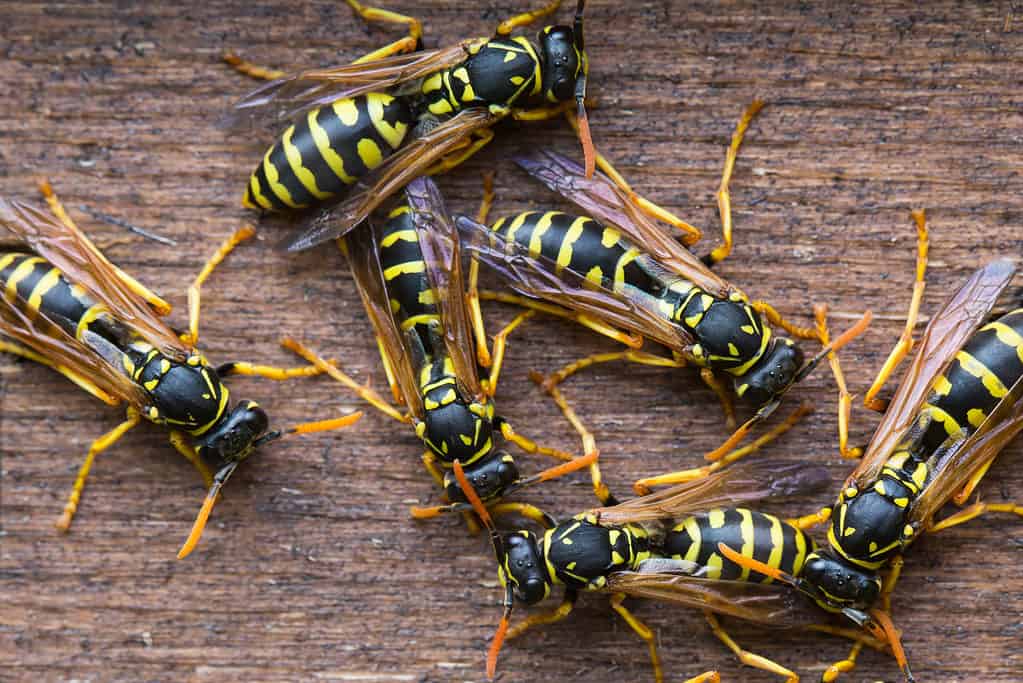
The Yellowjacket is among the most common types of wasps in the United States.
©FCerez/Shutterstock.com
In the United States, there are over 4,000 different varieties of wasps. Wasps have leaner, glossier bodies than bees, which have thick, hairy bodies. Not all wasps create nests the same. Here are some of the most common types of wasps you’ll find in and around your home.
Yellowjacket
One of the most prevalent and hostile wasp species is yellowjackets. These wasps have yellow bodies and black markings. They are fiercely protective of their territory and frequently sting when provoked.
Mud Dauber
Compared to other wasp species, these ones are less hostile. They can be identified by their lengthy, thin bodies and dark wings. Usually, they are dark or black, although occasionally this species can have yellow stripes.
Despite frequently constructing nests on houses and buildings, they hardly ever sting.
Paper Wasp
Paper wasps are brown in hue, much like mud daubers, but many have red stripes. They build umbrella-shaped paper nests that are visible on tree limbs, porch walls, door frames, and windows.
Bald-Faced Hornets
The bald-faced hornets are a huge, primarily black species that is also aggressive and has white or creamy patterns. They are among the most sociable insects since they enjoy residing in enormous colonies.
Be cautious in your garden because their spherical, papery nests are typically located in shrubs and trees.
Ways to NOT Remove a Wasps Nest

Some wasps build nests underground.
©iStock.com/Judy_Dautovich-Ralf_Hunsinger
You may have seen some methods online for removing a wasp nest the easy way. It’s essential to remember that just because something is easy, doesn’t make it safe or even effective.
Here is how you shouldn’t remove a wasp’s nest.
Using a Hose
A frequent technique people use to attempt to kill a wasp nest is the use of water.
Flooding the nest is not going to get rid of the wasps. It will simply make them more hostile toward you, resulting in painful stings.
Employing water on nests that are indoors can cause major property damage as well.
Lighting a Nest on Fire
Both dangerous and inefficient, using fire to destroy a wasp nest is not recommended. The thin, chewed-up wood pulp that makes up wasp nests is exceedingly flammable, making them extremely dangerous to have in or near your home.
The wasps won’t be killed by the fire either; instead, it will just make them become more aggressive.
Hitting the Nest With a Bat
Some people could try to smash their wasp nest with a baseball bat. This is the worst approach because it necessitates being right up to the nest, placing you in immediate danger of being stung and hurt.
How to Safely Remove a Wasp Nest
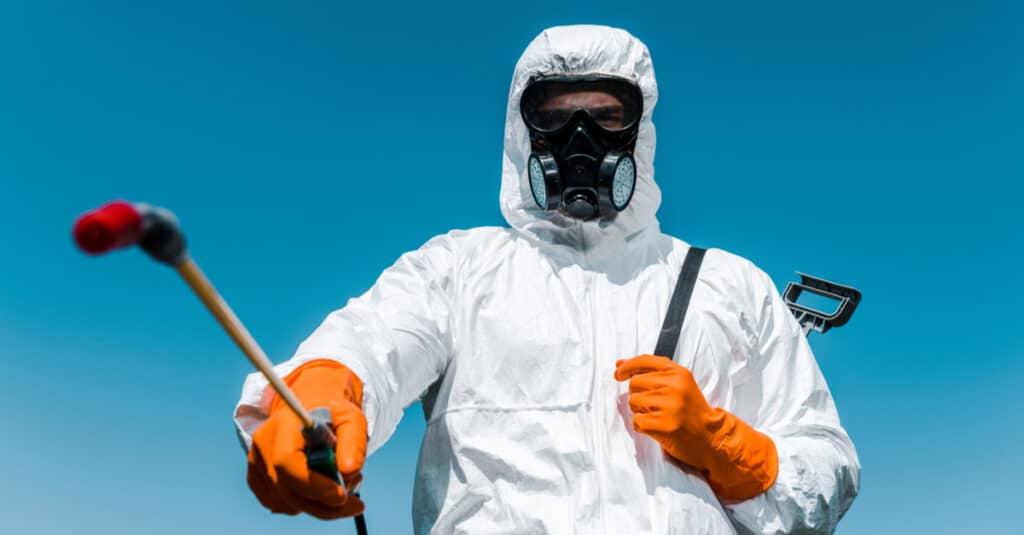
Hiring an exterminator is the easiest way to remove wasps and their nests.
©LightField Studios/Shutterstock.com
Now that you know how to not remove a wasp nest, let’s talk about effective ways to clear your home, inside and out, of these pesky insects.
1. Hire an Exterminator
Make the wise decision and hire a pro if you have even the slightest skepticism about your capacity to eliminate a wasp nest properly. In addition, if you are allergic to wasps, you should always call an exterminator since the hazards are simply too great.
Consider hiring a specialist if you have ground-nesting yellow jackets, which can be challenging to eradicate even using consumer-level pesticide dust applications. It’s also a good idea to hire a professional if the nest is in a hard-to-reach location.
Getting close to a wasp nest can be dangerous and, in rare instances, even lethal if something goes catastrophically wrong
2. Apply Pesticides
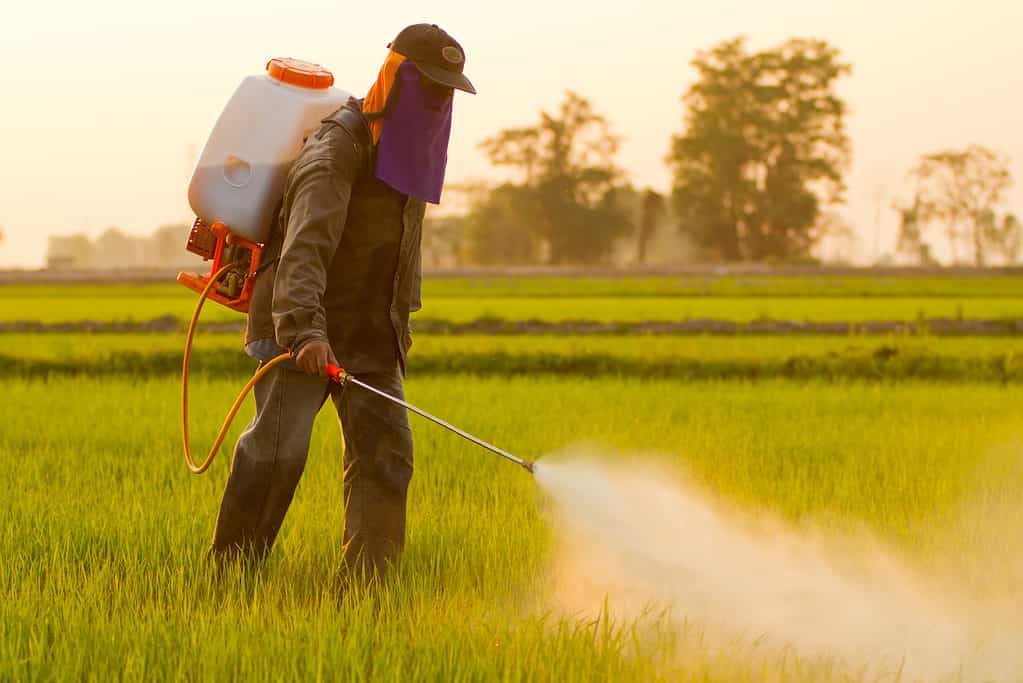
Many gardeners use pesticides in their gardens to keep away wasps and other bugs.
©PiggingFoto/Shutterstock.com
Spray pesticide in a stream at the nest. Keep a constant stream for 15 seconds or as per the instructions on the label. Next, leave the location as soon as possible. In order to ensure that there has been no further wasp activity, come back at least 24 hours later to monitor any activity.
Wasp spray operates effectively on visible hexagonal cells in open nests because you can readily soak both the wasps and the cells. If the nest is closed, direct the pesticide toward the main entrance. On nests that are underground or inside buildings, liquid pesticides are not as effective.
Purchase an aerosol insecticide made specifically for wasp control. Continue doing this if you continue to witness activity near the nest moving forward. When the wasp activity stops, destroy the nest by tearing it apart, saturating it with pesticide, and then throwing it away.
3. Use Insecticidal Dust
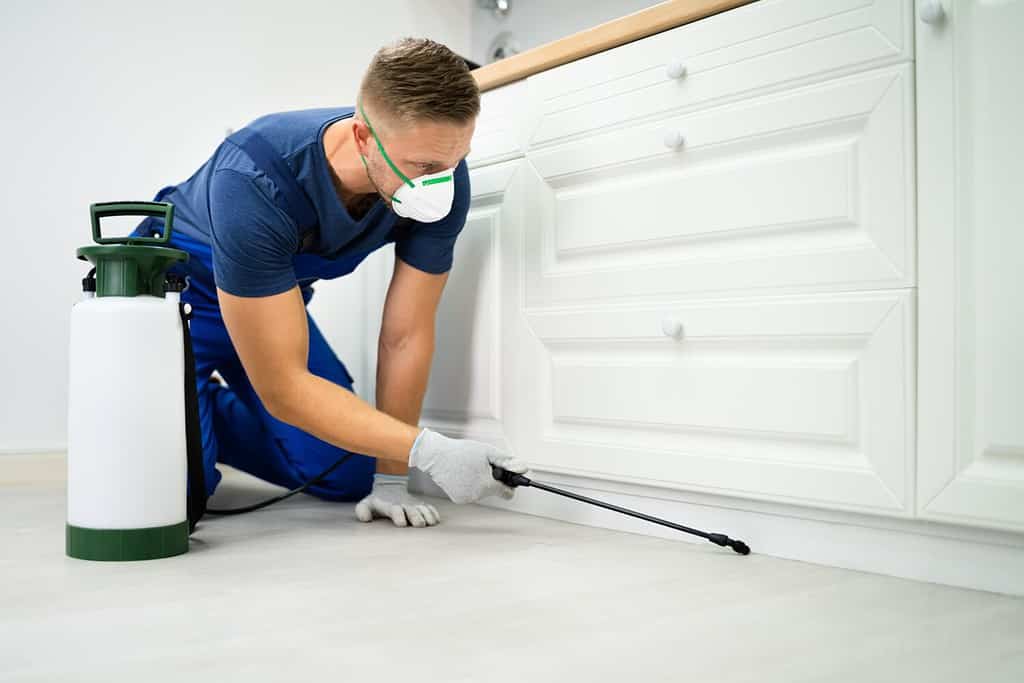
Some insecticides can be used inside and outdoors.
©Andrey_Popov/Shutterstock.com
Aerosol spray is substantially less effective than insecticidal dust for destroying nests embedded in tree trunks, shed walls, or the ground. Execute the following actions while keeping an eye out for safety.
Purchase some insecticide and pour about 1/4 cup into a bulb duster. If you don’t have a duster you can use a paper cup. Use a lot of dust to cover or fill the nest entrance. Please leave the area right away.
Avoid covering or blocking the entrance. The insecticidal dust will adhere to the legs and wings of the wasps as they navigate through the entryway and they will transport this dust into the core of the nest where it will contaminate the other wasps.
The wasps should disappear after the insecticidal dust has been applied within a couple of days Continue the process if necessary.
4. Bag a Nest
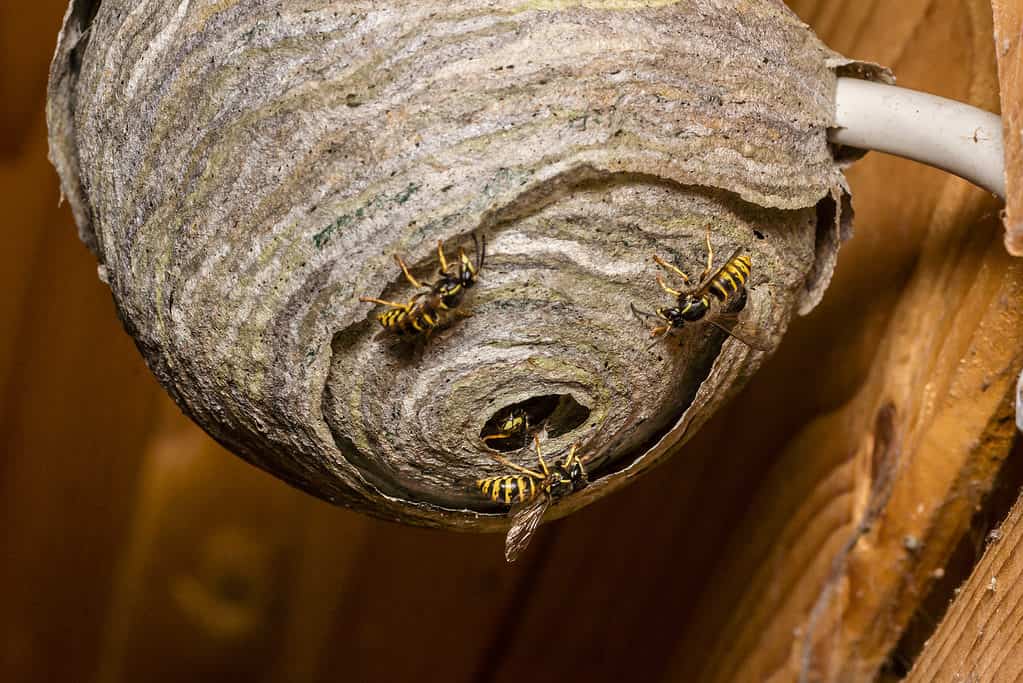
Bagging a wasp nest should never be done if you’re allergic.
©iStock.com/SKatzenberger
This approach, which is only appropriate for enclosed, hanging nests, requires getting up close and personal with the nest. This is not a great method for those without experience with removing nests.
Put a strong, hole-free cotton bag around the nest swiftly and securely. Securely fasten the top with rope or a piece of duct tape. Remove the nest off the tree limb as you move closer to the ground.
Place the bag in a large bucket of water and put a large rock on top to keep it submerged.
Make sure you keep the bagged nest in the water for at least eight hours to ensure all the wasps have drowned.
Tips For Getting Rid of a Wasp Nest
Here are some important tips to follow. These not only ensure that the nest removal will happen with ease, but you’ll remain safe throughout the process.
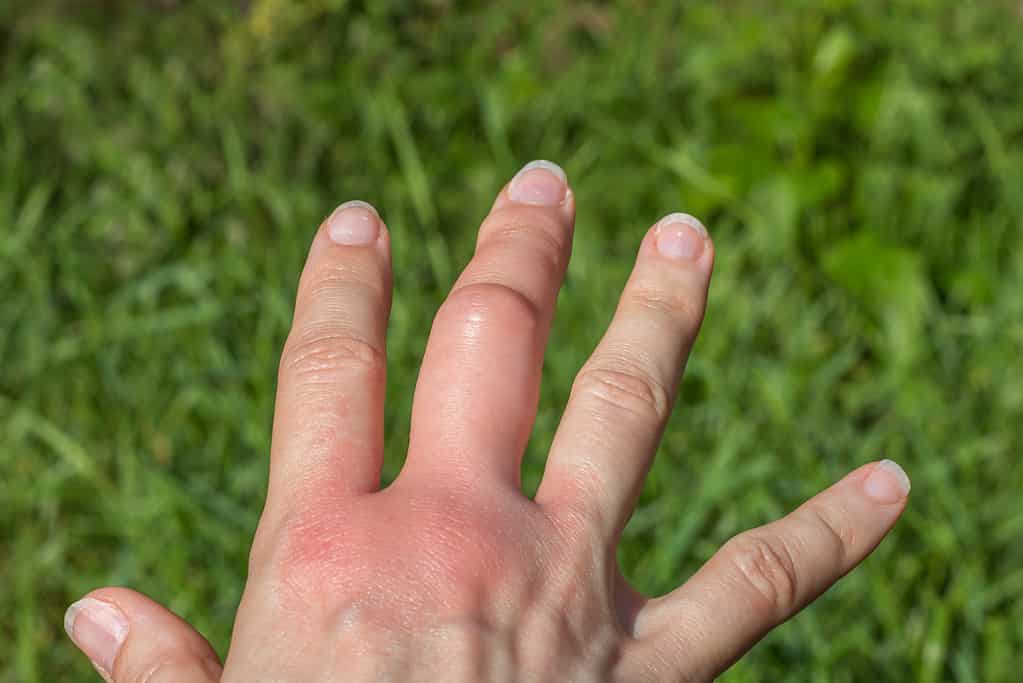
Use these tips to avoid getting stung by a wasp.
©iStock.com/Inna Kozhina
Wear Safety Gear
Dress in long pants, a thick jacket or coat, socks, and footwear. Make sure to tuck your pants into your socks. Wear a knitted hat or a robust, tightly-cinched hood to protect your head. You’ll also want a scarf and goggles to protect your eyes and face.
If you plan on using pesticides, make sure you’re wearing clothes that you’re okay throwing away.
Avoid Ladders
If a wasp nest is beyond your reach, like beneath the eave of a house or on a tall tree limb, don’t try to get to it using a ladder. When you’re standing on a ladder, it’s easier for wasps to warm you.
This puts you at risk of falling from a high height and getting injured. When you have a wasp in a higher location, call a professional to do the work for you.
Keep Kids and Pets Indoors
If you choose to use a pesticide sprayer or dust to get rid of the wasps, you should block off the space and be sure nobody enters for at least 24 hours, particularly young children and dogs.
Wasp-killing spray contains incredibly potent and toxic pesticides.
The photo featured at the top of this post is © Manu M Nair/Shutterstock.com
Thank you for reading! Have some feedback for us? Contact the AZ Animals editorial team.







